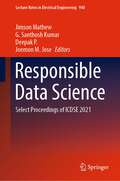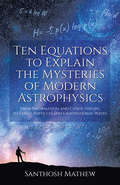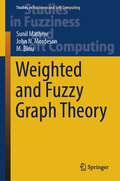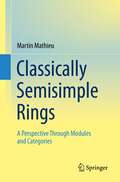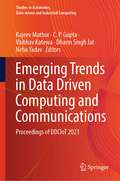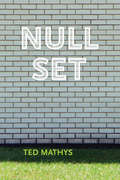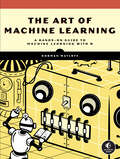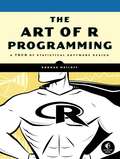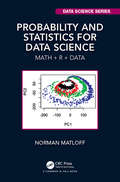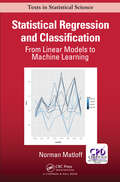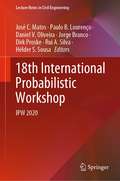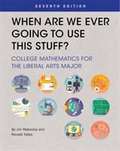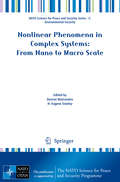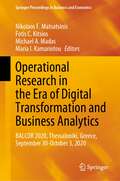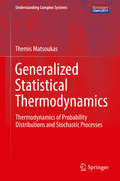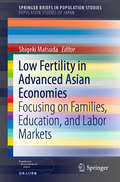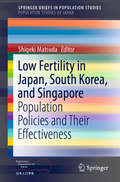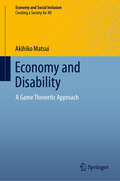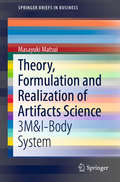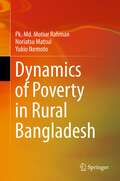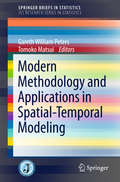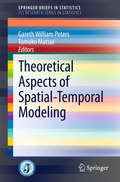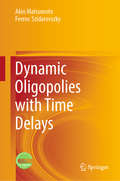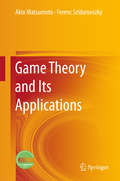- Table View
- List View
Responsible Data Science: Select Proceedings of ICDSE 2021 (Lecture Notes in Electrical Engineering #940)
by Jimson Mathew G. Santhosh Kumar Deepak P. Joemon M. JoseThis book comprises select proceedings of the 7th International Conference on Data Science and Engineering (ICDSE 2021). The contents of this book focus on responsible data science. This book tries to integrate research across diverse topics related to data science, such as fairness, trust, ethics, confidentiality, transparency, and accuracy. The chapters in this book represent research from different perspectives that offer novel theoretical implications that span multiple disciplines. The book will serve as a reference resource for researchers and practitioners in academia and industry.
Ten Equations to Explain the Mysteries of Modern Astrophysics: From Information and Chaos Theory to Ghost Particles and Gravitational Waves
by Santhosh MathewThis book introduces ten equations that transcend the boundaries of time and space. It takes readers through a journey of self-discovery where they will learn the history, science, and significance of these equations in the context of their lives. Moreover, the mathematical beauty of these equations is presented in a profoundly modest fashion to highlight the idea that equations are eternal but humans are transient. Each chapter offers readers a sublime experience and provides insights into the laws of nature that address the ever-expanding intricacy of our universe. The history of humankind, according to Franz Kafka, is the instant between two strides taken by a traveler. Therefore, what remains eternal when we finish our journey on this tiny rocky planet is our deep desire to connect with everything else in this universe. These equations capture the essence of that aspiration and remain everlasting while we continue our trivial human pursuits. Additionally, these ten equations change the way we live and view the world and will outlast even the most enduring signs of our civilization. They have the potential to take us from planet to planet and perhaps to make us a cosmic species. They can destroy the last strand of DNA to terminate life as we know it and generate life again from the fundamental laws of nature. While these equations are intangible, they can create a tangible world yet remain truly eternal. REVIEWS and WORDS OF PRAISE: In this enlightening, accessible, and brief book each highlighted equation receives a chapter that is an essay on its history and implication. This is a work written for a popular audience. No prerequisite mathematical sophistication is required to appreciate the mathematical beauty of these simple equations and their descriptive potential. It is the equation’s implication, not technical underpinnings, that is explored here. Each equation is a departure point to consider accepted and considered views on the nature of reality.... Reviewed by Tom Schulte on 07/28/2019. Read the rest of the review at The Mathematical Association of America. A fascinating overview of ten equations that describe the richness of reality from the laws of physics that control the physical universe to counting alien civilizations in the biological universe. Using philosophically inspired, yet scientifically accurate language, Santhosh Mathew captures the essence of these fundamental equations and their implications for our understanding of reality as well as what might become of it in the next century. Avi Loeb, Chair of the Astronomy Department, Harvard University and Founding Director, Black Hole Initiative (BHI) One chapter of this book introduces us to the Shannon entropy which underpins information theory. One can derive information only if it is unknown, since what is known is fixed and provides little or no new information. Does the quest for a complete explanation of the laws of physics then reduce the probability of new laws being found and proposed? If more is known about our existence, then will there be fewer future surprises? Physical laws and their mathematical representations express the beauty of our universe and underpin the universe. It is up to us to harness these laws for the greater good and prevent injurious applications. Ishwar K. Puri, Dean and Professor, Faculty of Engineering, McMaster University, Hamilton, Ontario, Canada
Weighted and Fuzzy Graph Theory (Studies in Fuzziness and Soft Computing #429)
by Sunil Mathew John N. Mordeson M. BinuOne of the most preeminent ways of applying mathematics in real-world scenario modeling involves graph theory. A graph can be undirected or directed depending on whether the pairwise relationships among objects are symmetric or not. Nevertheless, in many real-world situations, representing a set of complex relational objects as directed or undirected is not su¢ cient. Weighted graphs o§er a framework that helps to over come certain conceptual limitations. We show using the concept of an isomorphism that weighted graphs have a natural connection to fuzzy graphs. As we show in the book, this allows results to be carried back and forth between weighted graphs and fuzzy graphs. This idea is in keeping with the important paper by Klement and Mesiar that shows that many families of fuzzy sets are lattice isomorphic to each other. We also outline the important work of Head and Weinberger that show how results from ordinary mathematics can be carried over to fuzzy mathematics. We focus on the concepts connectivity, degree sequences and saturation, and intervals and gates in weighted graphs.
Classically Semisimple Rings: A Perspective Through Modules and Categories
by Martin MathieuClassically Semisimple Rings is a textbook on rings, modules and categories, aimed at advanced undergraduate and beginning graduate students.The book presents the classical theory of semisimple rings from a modern, category-theoretic point of view. Examples from algebra are used to motivate the abstract language of category theory, which then provides a framework for the study of rings and modules, culminating in the Wedderburn–Artin classification of semisimple rings. In the last part of the book, readers are gently introduced to related topics such as tensor products, exchange modules and C*-algebras. As a final flourish, Rickart’s theorem on group rings ties a number of these topics together. Each chapter ends with a selection of exercises of varying difficulty, and readers interested in the history of mathematics will find biographical sketches of important figures scattered throughout the text.Assuming previous knowledge in linear and basic abstract algebra, this book can serve as a textbook for a course in algebra, providing students with valuable early exposure to category theory.
Emerging Trends in Data Driven Computing and Communications: Proceedings of DDCIoT 2021 (Studies in Autonomic, Data-driven and Industrial Computing)
by Rajeev Mathur C. P. Gupta Vaibhav Katewa Dharm Singh Jat Neha YadavThis book includes best selected, high-quality research papers presented at International Conference on Data Driven Computing and IoT (DDCIoT 2021) organized jointly by Geetanjali Institute of Technical Studies (GITS), Udaipur, and Rajasthan Technical University, Kota, India, during March 20–21, 2021. This book presents influential ideas and systems in the field of data driven computing, information technology, and intelligent systems.
Null Set
by Ted MathysNull Set collects the slightly obsessive possibilities that rise when we give them the space--odd jobs, trouble-making, and farm boy rambling, all in dialogue with mathematics, or William Faulkner, or other poets.From "Hypotenuse":HYPOTENUSEI write three, erase it, blow rubbershavings from the desk. Write its notation,erase it, blow shavings. Then three 3serased, shavings blown, persistfor the nonce, three of nothing, nowhereattending to discrete objects for counting,themselves objects at any rate. To kiss,sleep, and focus we know to closeour eyes, imagine. I do, see nothing.
The Art of Machine Learning: A Hands-On Guide to Machine Learning with R
by Norman MatloffLearn to expertly apply a range of machine learning methods to real data with this practical guide.Packed with real datasets and practical examples, The Art of Machine Learning will help you develop an intuitive understanding of how and why ML methods work, without the need for advanced math.As you work through the book, you&’ll learn how to implement a range of powerful ML techniques, starting with the k-Nearest Neighbors (k-NN) method and random forests, and moving on to gradient boosting, support vector machines (SVMs), neural networks, and more.With the aid of real datasets, you&’ll delve into regression models through the use of a bike-sharing dataset, explore decision trees by leveraging New York City taxi data, and dissect parametric methods with baseball player stats. You&’ll also find expert tips for avoiding common problems, like handling &“dirty&” or unbalanced data, and how to troubleshoot pitfalls.You&’ll also explore:How to deal with large datasets and techniques for dimension reductionDetails on how the Bias-Variance Trade-off plays out in specific ML methodsModels based on linear relationships, including ridge and LASSO regressionReal-world image and text classification and how to handle time series dataMachine learning is an art that requires careful tuning and tweaking. With The Art of Machine Learning as your guide, you&’ll master the underlying principles of ML that will empower you to effectively use these models, rather than simply provide a few stock actions with limited practical use.Requirements: A basic understanding of graphs and charts and familiarity with the R programming language
The Art of R Programming: A Tour of Statistical Software Design
by Norman MatloffR is the world's most popular language for developing statistical software: Archaeologists use it to track the spread of ancient civilizations, drug companies use it to discover which medications are safe and effective, and actuaries use it to assess financial risks and keep economies running smoothly.The Art of R Programming takes you on a guided tour of software development with R, from basic types and data structures to advanced topics like closures, recursion, and anonymous functions. No statistical knowledge is required, and your programming skills can range from hobbyist to pro.Along the way, you'll learn about functional and object-oriented programming, running mathematical simulations, and rearranging complex data into simpler, more useful formats. You'll also learn to:–Create artful graphs to visualize complex data sets and functions–Write more efficient code using parallel R and vectorization–Interface R with C/C++ and Python for increased speed or functionality–Find new R packages for text analysis, image manipulation, and more–Squash annoying bugs with advanced debugging techniquesWhether you're designing aircraft, forecasting the weather, or you just need to tame your data, The Art of R Programming is your guide to harnessing the power of statistical computing.
Probability and Statistics for Data Science: Math + R + Data (Chapman & Hall/CRC Data Science Series)
by Norman MatloffProbability and Statistics for Data Science: Math + R + Data covers "math stat"—distributions, expected value, estimation etc.—but takes the phrase "Data Science" in the title quite seriously: <P><P> * Real datasets are used extensively. * All data analysis is supported by R coding. * Includes many Data Science applications, such as PCA, mixture distributions, random graph models, Hidden Markov models, linear and logistic regression, and neural networks. * Leads the student to think critically about the "how" and "why" of statistics, and to "see the big picture." * Not "theorem/proof"-oriented, but concepts and models are stated in a mathematically precise manner. <P><P> Prerequisites are calculus, some matrix algebra, and some experience in programming. <P><P> Norman Matloff is a professor of computer science at the University of California, Davis, and was formerly a statistics professor there. He is on the editorial boards of the Journal of Statistical Software and The R Journal. His book Statistical Regression and Classification: From Linear Models to Machine Learning was the recipient of the Ziegel Award for the best book reviewed in Technometrics in 2017. He is a recipient of his university's Distinguished Teaching Award.
Statistical Regression and Classification: From Linear Models to Machine Learning (Chapman & Hall/CRC Texts in Statistical Science)
by Norman Matloff<p>Statistical Regression and Classification: From Linear Models to Machine Learning takes an innovative look at the traditional statistical regression course, presenting a contemporary treatment in line with today's applications and users. <p>The book treats classical regression methods in an innovative, contemporary manner. Though some statistical learning methods are introduced, the primary methodology used is linear and generalized linear parametric models, covering both the Description and Prediction goals of regression methods. The author is just as interested in Description applications of regression, such as measuring the gender wage gap in Silicon Valley, as in forecasting tomorrow's demand for bike rentals. An entire chapter is devoted to measuring such effects, including discussion of Simpson's Paradox, multiple inference, and causation issues. Similarly, there is an entire chapter of parametric model fit, making use of both residual analysis and assessment via nonparametric analysis.</p>
18th International Probabilistic Workshop: IPW 2020 (Lecture Notes in Civil Engineering #153)
by José C. Matos Paulo B. Lourenço Daniel V. Oliveira Jorge Branco Dirk Proske Rui A. Silva Hélder S. SousaThis volume presents the proceedings of the 18th International Probabilistic Workshop (IPW), which was held in Guimarães, Portugal in May 2021. Probabilistic methods are currently of crucial importance for research and developments in the field of engineering, which face challenges presented by new materials and technologies and rapidly changing societal needs and values. Contemporary needs related to, for example, performance-based design, service-life design, life-cycle analysis, product optimization, assessment of existing structures and structural robustness give rise to new developments as well as accurate and practically applicable probabilistic and statistical engineering methods to support these developments. These proceedings are a valuable resource for anyone interested in contemporary developments in the field of probabilistic engineering applications.
When Are We Ever Going to Use this Stuff?: College Mathematics for the Liberal Arts Major
by James Matovina Ronald YatesWhen Are We Ever Going to Use This Stuff? College Mathematics for the Liberal Arts Major is a college level mathematics textbook designed with liberal arts majors in mind. Standard mathematics texts typically mimic the style and tone of those written for STEM-track students. This text, while rigorous enough to ensure a high level of mastery over the material, uses practical, entertaining topics presented in a readable, student-centered style to teach mathematics concepts and skills for the non-major. When Are We Ever Going to Use This Stuff? emphasizes practical application over symbolic manipulation across several different topics that are ideal for the liberal arts major. Students learn where, when, why, and how the math will help them in their lives. The subject matter includes consumer math, apportionment, statistics, probability, set theory, geometry, right triangle trigonometry, and voting techniques, with the history of mathematics as a consistent motivational thread throughout. Concepts are taught within familiar contexts, with a focus on the development of problem-solving skills. When Are We Ever Going to Use This Stuff? is a fresh, student-friendly offering for lower-division courses that meet the math requirement for liberal arts students. Jim Matovina earned his M.S. in mathematics and a post-baccalaureate certificate in statistics at Purdue University Calumet. Professor Matovina teaches at the College of Southern Nevada, where he has also served as chair of the math department, as well as the department's webmaster. Ronald Yates earned his M.S. in mathematics at Montana State University and holds an M.Ed. in higher education leadership from the University of Nevada, Las Vegas. He is a professor of mathematics at the College of Southern Nevada, where he has served as the department's webmaster and parliamentarian.
Nonlinear Phenomena in Complex Systems: From Nano to Macro Scale
by Davron Matrasulov H. Eugene StanleyTopics of complex system physics and their interdisciplinary applications to different problems in seismology, biology, economy, sociology, energy and nanotechnology are covered in this new work from renowned experts in their fields. In particular, contributed papers contain original results on network science, earthquake dynamics, econophysics, sociophysics, nanoscience and biological physics. Most of the papers use interdisciplinary approaches based on statistical physics, quantum physics and other topics of complex system physics. Papers on econophysics and sociophysics are focussed on societal aspects of physics such as, opinion dynamics, public debates and financial and economic stability. This work will be of interest to statistical physicists, economists, biologists, seismologists and all scientists working in interdisciplinary topics of complexity.
Operational Research in the Era of Digital Transformation and Business Analytics: BALCOR 2020, Thessaloniki, Greece, September 30-October 3, 2020 (Springer Proceedings in Business and Economics)
by Nikolaos F. Matsatsinis Fotis C. Kitsios Michael A. Madas Maria I. KamariotouThis proceedings volume presents new methods and applications in Operational Research and Management Science with a special focus on Business Analytics. Featuring selected contributions from the XIV Balkan Conference on Operational Research held in Thessaloniki, Greece in 2020 (BALCOR 2020), it addresses applications and methodological tools or techniques in various areas of Operational Research, such as agent-based modelling, big data and business analytics, data envelopment analysis, data mining, decision support systems, fuzzy systems, game theory, heuristics, metaheuristics and nature inspired optimization algorithms, linear and nonlinear programming, machine learning, multiple criteria decision analysis, network design and optimization, queuing theory, simulation and statistics.
Generalized Statistical Thermodynamics: Thermodynamics of Probability Distributions and Stochastic Processes (Understanding Complex Systems)
by Themis MatsoukasThis book gives the definitive mathematical answer to what thermodynamics really is: a variational calculus applied to probability distributions. Extending Gibbs's notion of ensemble, the Author imagines the ensemble of all possible probability distributions and assigns probabilities to them by selection rules that are fairly general. The calculus of the most probable distribution in the ensemble produces the entire network of mathematical relationships we recognize as thermodynamics. The first part of the book develops the theory for discrete and continuous distributions while the second part applies this thermodynamic calculus to problems in population balance theory and shows how the emergence of a giant component in aggregation, and the shattering transition in fragmentation may be treated as formal phase transitions. While the book is intended as a research monograph, the material is self-contained and the style sufficiently tutorial to be accessible for self-paced study by an advanced graduate student in such fields as physics, chemistry, and engineering.
Low Fertility in Advanced Asian Economies: Focusing on Families, Education, and Labor Markets (SpringerBriefs in Population Studies)
by Shigeki MatsudaThis book focuses on the links between family, education, and employment systems in the Asian developed economies, proposing that these three systems and their interrelations are powerful factors causing the low fertility in Asia.The phenomenon of low fertility has been widely observed in developed countries, and the birthrate in Asian countries is among the lowest in the world. Although these countries have implemented measures to counter the falling birthrate, the expected effect has not yet been achieved. Moreover, Asia has seen a rapid decrease in the number of marriages. To promote effective countermeasures, it is necessary to clarify the factors influencing the low birthrate and decline in the number of marriages. Based on a statistical analysis of survey results mainly from Japan, South Korea, and Singapore, this book discusses several important points. First, because the family system is strong, cohabitation and children born to single mothers are not socially accepted. Further, mothers play a strong role in fulfilling expectations for children’s education. Second, the popularization of higher education and intense academic competition, which have been a driving force for rapid economic growth, have led to many parents opting to have fewer children, as the cost of education is high. Lastly, wage disparity is large and employment stability is a matter of concern. These factors increase competition within education and, in turn, make it difficult for the young generation to choose marriage. Within the employment environment, balancing work and family life is problematical, especially for women.
Low Fertility in Japan, South Korea, and Singapore: Population Policies and Their Effectiveness (SpringerBriefs in Population Studies)
by Shigeki MatsudaThis book describes the low fertility status in three developed Asian countries—Japan, South Korea, and Singapore—and outlines countermeasures for their declining birthrates. Based on the characteristics of each society, the authors discuss why their fertility rates have not yet recovered. Low fertility is a demographic phenomenon that first occurred in Europe and subsequently spread across other countries. Currently, the fertility rates in Europe are relatively stable, while those in developed Asian economies are the lowest worldwide. This may cause labor shortages and weaken their social security systems, undermining Asia’s social and economic sustainability despite its remarkable economic development. In response to low fertility, some Asian countries have implemented countermeasures: Japan has introduced measures based on childcare facilities and work–life balance. Similarly, since the mid-2000s South Korea has established countermeasures to promote a balance between work and child rearing, as well as expanded childcare services. Singapore began introducing countermeasures before the other two countries, including various advanced measures. Yet none of these countries has seen a full recovery in fertility rates. Based on a statistical analysis of survey results from the three countries, this book makes several important points. The first is that the policy has been ineffective in Japan due to a discrepancy between the needs of parents raising children and those who are the targets of the countermeasures. Second, the work–life balance and child-rearing support measures that have been promoted in Japan and South Korea have not affected the number of children that women want to have. Third, Singaporean values tend to place individual emphasis on competition with oneself (education and career status) rather than on married life. This intense competition has lowered fertility rates. To restore these rates, each country must promote policies that better address its specific issues.
Changes in Work and Family Life in Japan Under COVID-19 (SpringerBriefs in Population Studies)
by Shigeki Matsuda Hirohisa TakenoshitaThis book describes how the COVID-19 pandemic has affected the way of work, the division of household labor, and family formation in Japan. One of the characteristics of Japanese employment practices is a stable employer–employment relationship and seniority-based wage system. In return, long working hours, especially for men who are called “salarymen” (salaried workers, or “company men”), are required. The pandemic has led to an expansion of telework and has reduced their working hours, which has made them return to their homes to work. In contrast, non-regular employees, who are mostly women, has become more unstable in employment and their incomes fell. This tendency has become even stronger under the pandemic.Compared with conditions in Western countries, in Japan wives have a greater responsibility for domestic chores. In the pandemic, as children's classes shifted to online and childcare support facilities were temporarily closed, the burden of housework and child-rearing increased for wives. However, husbands who worked from home shared a part of the housework, and popular home delivery services helped to reduce the burdens on wives. Japan is one of the developed countries with low fertility rates. Under the pandemic, many Japanese postponed starting a family, which further shrank the country’s birthrate. There was a remarkably significant tendency to postpone having children among economically disadvantaged and socially isolated families. This book provides a portrait of Japan’s experience regarding the notable impacts of the pandemic on work and family life.
Economy and Disability: A Game Theoretic Approach (Economy and Social Inclusion)
by Akihiko MatsuiSociety has developed so that it accommodates the needs of intertwined people, but a question arises as to which people have been accommodated. Has everyone been taken care of in an equal manner? If not, who has fallen into the gap between the institutions that are supposed to accommodate them? This book is a study of these issues of economy and disability using game theory, which has provided a means of analyzing various social phenomena. Part I provides actual cases related to economy and disability, with the stories based on interviews by the author. Part II is geared toward a game theoretic analysis. This book explains disability-related issues by game theory and innovates that theory by deeply contemplating the issues.It is not common that first-rate theorists manage to make their research relevant and applicable to the most pressing problems our society faces these days. This is the remarkable achievement of this book. Akihiko Matsui, an internationally recognized leader in economic theory, succeeds in bringing profound game theoretical insights to the questions of disability, the social norms relating to it, and the ethical and economic problems they raise. The book is a tour de force, brilliantly combining economic and sociology, mathematics and philosophy, to provide us a fresh look at the way we run modern societies.Itzahk Gilboa, Professor, Eitan Berglas School of Economics, Tel-Aviv University and Professor of Economics and Decision Sciences, HEC, ParisThe present world faces a broad range of societal problems such as discrimination against minorities and conflicts between groups. The market mechanism may solve some of these dilemmas, but many others remain. This book targets various societal problems and provides game theoretical approaches to them, stressing the importance of social institutions including the market system and individual interactive attitudes to society. Aki Matsui’s splendid Economy and Disability is indispensable for students and scholars interested in social science, particularly in economic theory, and gives a better understanding of these phenomena and their potential cures.Mamoru Kaneko, Professor, Faculty of Political Science and Economics, Waseda UniversityIn this book, Aki Matsui is revealed to be a fully-fledged humanist in the guise of a game theoretician. He beautifully presents game-theoretical ideas while at the same time suggesting how society should relate to the disabled. This unique combination makes Economy and Disability—apart from anything else—a truly moving book.Ariel Rubinstein, Professor of Economics, Eitan Berglas School of Economics, Tel-Aviv University and Professor of Economics, New York University
Theory, Formulation and Realization of Artifacts Science: 3M&I-Body System (SpringerBriefs in Business)
by Masayuki MatsuiThis book considers and builds on the main propositions regarding body similarity and the principles of nature versus artifacts in science. It also explores the design (matrix) power of the human, Material/Machine, Money & Information (3M&I) body with respect to productivity/gross domestic product (GDP). The book begins in 2009 with Weiner’s cybernetics and describes Matsui’s theory and dynamism concerning the basic equation of W = ZL and artifact formulation using matrix methods, such as Matsui’s matrix equation (Matsui’s ME). In his book Fundamentals and Principles of Artifacts Science: 3M&I-Body System, published by Springer in 2016, the author championed the white-box approach for 3M&I artifacts in contrast to Simon’s artificial approach from 1969. Two principles, the Sandwich (waist) and Balancing theories, and their fundamental problems, were identified. This book now proposes a third principle: the fractal/harmonic-like structure of the cosmos and life types in space and time. The book further elaborates on the complexity of the 3M&I system and management in terms of enterprises, economics, nature, and other applications. Also, the domain of nature versus artifacts is highlighted, demonstrating the possibility of a white-box cybernetics-type robot. This fosters the realization of humanized and harmonic worlds that combine increased happiness and social productivity in an age increasingly dominated by technology.
Dynamics of Poverty in Rural Bangladesh
by Noriatsu Matsui Yukio Ikemoto Pk. Md. RahmanThe study of poverty dynamics is important for effective poverty alleviation policies because the changes in income poverty are also accompanied by changes in socioeconomic factors such as literacy, gender parity in school, health care, infant mortality, and asset holdings. In order to examine the dynamics of poverty, information from 1,212 households in 32 rural villages in Bangladesh was collected in December 2004 and December 2009. This book reports the analytical results from quantitative and qualitative surveys from the same households at two points of time, which yielded the panel data for understanding the changes in situations of poverty. Efforts have been made to include the most recent research from diverse disciplines including economics, statistics, anthropology, education, health care, and vulnerability study. Specifically, findings from logistic regression analysis, polychoric principal component analysis, kernel density function, income mobility with the help of the Markov chain model, and child nutrition status from anthropometric measures have been presented. Asset holdings and liabilities of the chronically poor as well as those of three other economic groups (the descending non-poor, the ascending poor, and the non-poor) are analyzed statistically. The degrees of vulnerability to poverty are examined by years of schooling, landholding size, gender of household head, social capital, and occupation. The multiple logistic regression model was used to identify important risk factors for a household's vulnerability. In 2009, some of the basic characteristics of the chronically poor were: higher percentage and number of female-headed households, higher dependency ratio, lower levels of education, fewer years of schooling, and limited employment. There was a low degree of mobility of households from one poverty status to another in the period 2004-2009, implying that the process of economic development and high economic growth in the macroeconomy during this time failed to improve the poverty situation in rural Bangladesh.
Modern Methodology and Applications in Spatial-Temporal Modeling
by Tomoko Matsui Gareth William PetersThis book provides a modern introductory tutorial on specialized methodological and applied aspects of spatial and temporal modeling. The areas covered involve a range of topics which reflect the diversity of this domain of research across a number of quantitative disciplines. For instance, the first chapter deals with non-parametric Bayesian inference via a recently developed framework known as kernel mean embedding which has had a significant influence in machine learning disciplines. The second chapter takes up non-parametric statistical methods for spatial field reconstruction and exceedance probability estimation based on Gaussian process-based models in the context of wireless sensor network data. The third chapter presents signal-processing methods applied to acoustic mood analysis based on music signal analysis. The fourth chapter covers models that are applicable to time series modeling in the domain of speech and language processing. This includes aspects of factor analysis, independent component analysis in an unsupervised learning setting. The chapter moves on to include more advanced topics on generalized latent variable topic models based on hierarchical Dirichlet processes which recently have been developed in non-parametric Bayesian literature. The final chapter discusses aspects of dependence modeling, primarily focusing on the role of extreme tail-dependence modeling, copulas, and their role in wireless communications system models.
Theoretical Aspects of Spatial-Temporal Modeling
by Tomoko Matsui Gareth William PetersThis book provides a modern introductory tutorial on specialized theoretical aspects of spatial and temporal modeling. The areas covered involve a range of topics which reflect the diversity of this domain of research across a number of quantitative disciplines. For instance, the first chapter provides up-to-date coverage of particle association measures that underpin the theoretical properties of recently developed random set methods in space and time otherwise known as the class of probability hypothesis density framework (PHD filters). The second chapter gives an overview of recent advances in Monte Carlo methods for Bayesian filtering in high-dimensional spaces. In particular, the chapter explains how one may extend classical sequential Monte Carlo methods for filtering and static inference problems to high dimensions and big-data applications. The third chapter presents an overview of generalized families of processes that extend the class of Gaussian process models to heavy-tailed families known as alpha-stable processes. In particular, it covers aspects of characterization via the spectral measure of heavy-tailed distributions and then provides an overview of their applications in wireless communications channel modeling. The final chapter concludes with an overview of analysis for probabilistic spatial percolation methods that are relevant in the modeling of graphical networks and connectivity applications in sensor networks, which also incorporate stochastic geometry features.
Dynamic Oligopolies with Time Delays
by Akio Matsumoto Ferenc SzidarovszkyThis is the first book to comprehensively examine the asymptotic behavior of dynamic monopolies, duopolies, and oligopolies where firms face information and implementation delays. It considers discrete and continuous timescales, continuously distributed delays, as well as single and multiple delays. It also discusses models with linear and hyperbolic price functions in three types of oligopolies: Cournot competition with quantity-adjusting firms, Bertrand competition with price-adjusting firms, and mixed oligopolies with both types of firms. In addition to the traditional Cournot-Nash equilibria, it introduces cases of partial cooperation are also introduced, leading to the analysis of cartelizing groups of firms and possible governmental actions against antitrust behavior. Further, the book investigates special processes for firms learning about the uncertain price function based on repeated market information. It addresses asymptotic properties of the associated dynamic systems, derives stability conditions, identifies stability switching curves, and presents in global analyses of cases of instability. The book includes both theoretical results and computer studies to illustrate and verify the theoretical findings.
Game Theory and Its Applications
by Akio Matsumoto Ferenc SzidarovszkyThis book integrates the fundamentals, methodology, and major application fields of noncooperative and cooperative games including conflict resolution. The topics addressed in the book are discrete and continuous games including games represented by finite trees; matrix and bimatrix games as well as oligopolies; cooperative solution concepts; games under uncertainty; dynamic games and conflict resolution. The methodology is illustrated by carefully chosen examples, applications and case studies which are selected from economics, social sciences, engineering, the military and homeland security. This book is highly recommended to readers who are interested in the in-depth and up-to-date integration of the theory and ever-expanding application areas of game theory.
